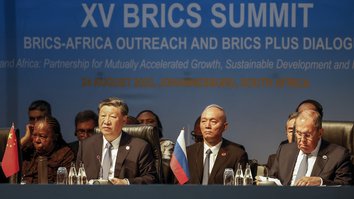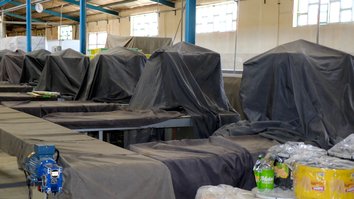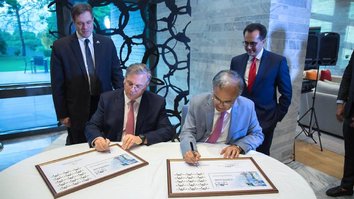Almost three years after the death of Islamic Revolutionary Guard Corps Quds Force (IRGC-QF) commander Qassem Soleimani in a US strike in Baghdad, the legacy of bloodshed and assassinations he left behind is still unfolding.
Soleimani, who not only commanded external military operations throughout the region but also was involved in repressing dissent inside Iran, was killed on January 3, 2020.
He was succeeded by Esmail Qaani, who has failed to demonstrate Soleimani's leadership qualities.
Yet despite a much weaker QF under Qaani, the Iranian regime insists on upholding Soleimani's legacy at the expense of the people of Iran and the wider Middle East region, from Syria to Yemen.
![A Yemeni family sits outside a cave where they sought refuge from poverty and lack of housing, west of Taez. [Ahmad al-Basha/AFP]](/cnmi_pf/images/2022/12/12/39519-000_8wc9cu__1_-585_329.jpg)
A Yemeni family sits outside a cave where they sought refuge from poverty and lack of housing, west of Taez. [Ahmad al-Basha/AFP]
Reports indicate that Soleimani, known as Iran's most dangerous man, was planning in his last years to reshape the map of the Middle East to serve Iran's interests by using regional paramilitary groups to spread havoc.
Before his death, he had formed 82 armed entities in Iraq and Syria that are affiliated with the IRGC and receive funding and support from it, a number confirmed last year by Maj. Gen. Yahya Rahim-Safavi, military adviser to Iranian leader Ali Khamenei.
Soleimani commanded these proxy groups himself and supervised their training and the process of equipping them with weapons and money so they could grow and expand in the region.
According to Rahim-Safavi, the number of militants recruited by Iran since 2011 to fight in Syria in defence of its ally, the Bashar al-Assad regime, surpassed 70,000 --- coming from Iraq, Lebanon, Syria, Afghanistan and Pakistan. They operate under the IRGC umbrella.
The IRGC has spent some $30 billion on the Syria war, said Hashmatullah Falahat-Pisheh, former chairman of the Security Committee in Iran's Majles (parliament), in a May 2020 interview with the Iranian daily Etemad.
Under Soleimani's command, the militias launched hostilities against the residents of eastern Syria towns, before their strength declined and their activity diminished as a result of air strikes carried out by the international coalition.
Plan for regional hegemony
"The process of changing the demographic makeup of these towns [in eastern Syria] was part of Soleimani's plan for hegemony aimed at consolidating his country's regional interests," said Council of Syrian Tribes and Clans spokesman Mudar Hammad al-Asaad.
Iran-affiliated militias seized, by force or through financial incentives, hundreds of houses and farms to settle foreign elements and their families in them.
They also used the houses and farms as military headquarters and warehouses to store Iranian weapons smuggled across the border into Syria.
The confiscation of property led to "the displacement of thousands of Syrians in the cities of al-Mayadeen, Palmyra, Albu Kamal and Deir Ezzor", al-Asaad said.
The militias converted mosques into advocacy centres that teach the Iranian regime's principles, obliterating Syrians' national and religious identity, he added.
"Soleimani's legacy was represented in the assassination and liquidation of large numbers of Syrians who opposed the Iranian influence, as well as the imprisonment of some in secret detention centres, where a number of them were tortured to death," he said.
The militias have also forced residents, through threats and intimidation, to join their ranks, with the number of local recruits reaching "about 3,000" since the beginning of last year, according to a November 7 report by the Syrian Observatory for Human Rights.
Continued crimes against humanity in Iraq
In Iraq, IRGC-affiliated groups, the most brutal of which are Kataib Hizbullah and Asaib Ahl al-Haq, were responsible for horrific crimes, especially in Mosul and Anbar, political researcher Abdel Qader al-Nayel told Al-Mashareq.
The Iran-backed factions "forcibly disappeared and killed thousands of innocent Iraqis" in the battles against the "Islamic State of Iraq" (ISIS) and during the popular protests against corruption and the expansion of Iranian influence in late 2019, he said.
"The hostile behaviour of the militias, which were established by Soleimani, continued even after his assassination," al-Nayel said.
"Despite the clear impact of Soleimani's assassination on the militias' leaders, the plurality of decision makers and the struggle for influence, their activities did not stop," he said.
Retaliatory rocket attacks on sovereign and international facilities continued, threatening the safety of civilians, he said, and so did the assassination of activists and the smuggling of weapons and narcotics, exhausting the Iraqi economy.
Kataib Hizbullah was behind a failed February drone attack on the United Arab Emirates (UAE), one of several to threaten the security of the Gulf region, and last year launched a similar attack on Saudi Arabia's capital, Riyadh.
Soleimani's ambitions for control and regional expansion were not confined to Syria and Iraq but extended to Lebanon, which is ravaged by an economic crisis.
Politicians and citizens blame Hizbullah's corruption, both inside Lebanon and in its dealings abroad, for the country's economic collapse.
They say that the party's subservience to its main supporter, Iran, has invited the imposition of US sanctions on its leaders -- and the Lebanese people are paying the price.
Prolonging Houthis' war in Yemen
Soleimani's regional ambitions have reached Yemen, where the IRGC supports the Houthis with weapons, money and technical expertise to target the security of Gulf countries with ballistic missiles and drones.
Assad Kanjo, a researcher at the Centre for Arab Progress, highlighted in an October 25 report Soleimani's crucial role in "enabling the Houthis to hold fast and overthrow the state and its institutions" in Yemen.
He said the former IRGC-QF commander took advantage of heightened tensions after the start of the war between the Saudi-led Arab coalition and the Houthis to support the militia, thus prolonging the conflict, which entered its seventh year in March.
Soleimani's plan to turn Yemen into a new launching pad in Iran's proxy wars had disastrous consequences on living conditions for Yemenis, who are suffering from "the biggest humanitarian crisis in the world", according to the United Nations.

![Members of Iran-backed militias who fought and died in Syria are buried in Qom, Iran, in November. [Mohammad Vahdati/IRIB News]](/cnmi_pf/images/2022/12/12/39518-funeral-585_329.jpg)






